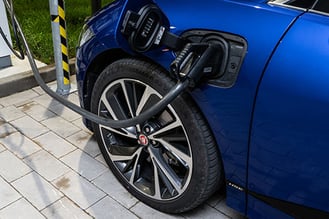Keeping your sales skills at the cutting edge of sales enablement means staying aware of the cutting edge of technology. Sales teams need to understand how technology is changing the way goods are manufactured and distributed. Below we look at the way technology is changing the underlying factors in how goods will be distributed across the country over the coming years.
Understanding the future of electric vehicles is critical if salespeople are going to factor it into their offerings.
Whether you’re directly working in the automotive parts sector or rely on an unstoppable flow of trucks across the country to deliver goods, offering your customers the best pricing may mean factoring in production costs and how cheaply goods can be distributed across the country.
The advantages of electric vehicles
Road users in the U.S. cover more than 3.25 trillion miles every year (increasing by around 1% year on year). Because of the increased weight of electric vehicles (those large batteries pack a weighty punch), more of the tire connects with the road. This means a faster acceleration from the off, but it also means there’s increased wear on the tire.
Zohr, the tire replacement company reckons they are seeing electric vehicle (EV) owners coming back for new tires 30% more often than traditional vehicle owners. Good news for the tire industry, and something to factor in when selling into any business that is making the shift to electric over the coming years.
Road users in the U.S. cover more than 3.25 trillion miles every year.
Naturally, there may be some play in the numbers as the cost of electric vehicles shifts according to increased uptake and cheaper materials used in their manufacturing. For example, the cost of electric trucks shifts as the technology onboard increases. Take the almost force-field-like array of sensors around many vehicles. With more sensors across the entire shell of a vehicle, they need to keep those sensors free of dirt and rain requires materials with a higher aquaphobic capability, or more wipers. Better dirt and moisture repelling materials could also lead to reductions in general wear and tear on the road.
Tired and ready to roll
 Another hidden outcome of the need to keep fleets of trucks on the road, particularly for just-in-time (JIT) inventory systems may be an upswing in the need for businesses that can respond quickly to replace tires anywhere/any time. If the greatest threat to mid-journey maintenance is tire replacement, unlike the combustion engine’s broader engineering concerns is the tires, then businesses that offer guaranteed uptimes will see a higher uptake of their services. And one thing that may make a difference is understanding where the suppliers are located.
Another hidden outcome of the need to keep fleets of trucks on the road, particularly for just-in-time (JIT) inventory systems may be an upswing in the need for businesses that can respond quickly to replace tires anywhere/any time. If the greatest threat to mid-journey maintenance is tire replacement, unlike the combustion engine’s broader engineering concerns is the tires, then businesses that offer guaranteed uptimes will see a higher uptake of their services. And one thing that may make a difference is understanding where the suppliers are located.
In it for the long haul
The distances between manufacturing plants and consumers will need to be factored in to allow for stopover periods while vehicles recharge. U.S. President Joe Biden has suggested that over half of all U.S. vehicles sales will be electric, by the year 2030. At present, there are just 43, 800 electric charging stations in the country, but the government has budgeted $7.5billion for charging stations over the coming years.
In countries like the UK where distances are shorter, there’s a chance that the evolution of the range for electric vehicles will easily be sufficient to cope.
The shape of things to come
In September 2020 Daimler unveiled its plans for electrifying its heavy vehicle fleet offering. Leading the charge is their Mercedes-Benz eActros LongHaul, a new long-range electric truck, and concept fuel cell truck. Daimler’s new eActros LongHaul will have a range of about 500 km (310 miles). This should go into series production sometime in 2024. The Mercedes-Benz GenH2 Truck, will have a range of around 1,000 kilometers.
It’s impossible to discuss electric vehicles without the name Tesla coming up. Tesla has a semi (aptly named the Tesla Semi) that promises a range of 300 or 500 miles, depending on the model. Production is planned for 2022. On an 80% charge, delivered in 30 minutes, it would be able to run for around 400 miles.
Sales teams wanting to monitor the development of the electric vehicle market should keep track of the development of battery capability. How this evolves over the coming years will make all the difference to how quickly vehicles can charge and how long they can go between charges.
Electric road haulage is in the early stages of development right now. Whatever industry you're selling into, the past year of lower production due to the pandemic, and Brexit in the U.K. has shown that distribution networks are apt to fluctuate and diminish at a moment's notice. Staying fully charged and tracking those fluctuations should help to deliver a better selling experience for you and your customers.



